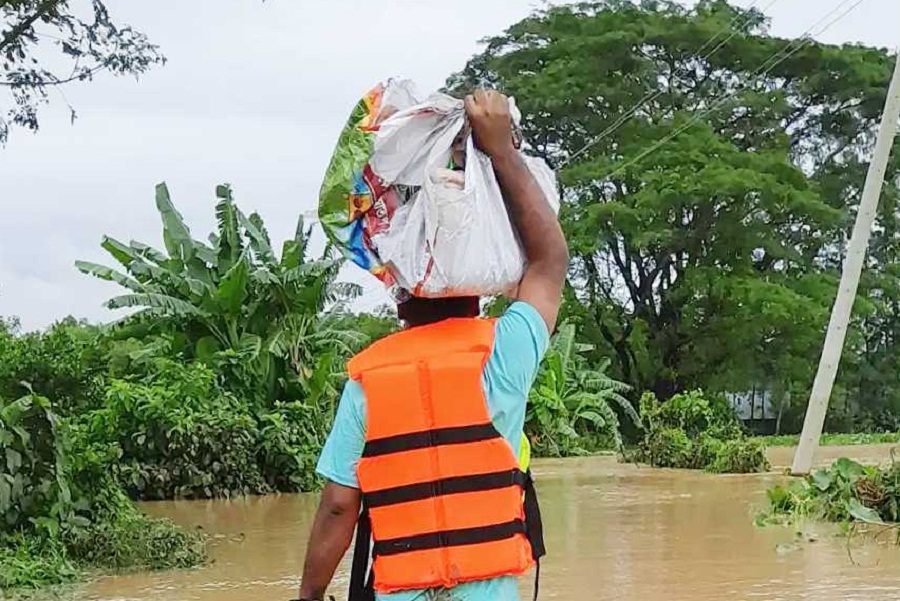Story of the rescuers: Bangladeshi youths in the flood rescue operations

Published :
Updated :

Bangladesh is currently experiencing an extraordinary chapter in its history. On one side, the nation is fighting with one of the most catastrophic floods it has ever seen. Many areas in districts like Feni, Noakhali, Cumilla, and others are submerged, leaving people in peril as their homes, livelihoods, and even their pets are swept away. But on the other hand, the youth of the country went alert. They are working tirelessly to help the flood-affected people.
Without any institutional training, many went into the water to rescue people, and the number is mammoth. This is unprecedented. Young children, some as young as eight, have brought their savings—money they had eagerly set aside for toys to donate to the affected people. When their country called, they set aside their small dreams and made a heartfelt sacrifice to help those devastated by the floods.
Initially, on a large scale at the TSC of the University of Dhaka, the Boisommo Birodhi Chatro Andolon started to raise funds using the banner "Gonotraan", and it went pretty fascinating.
Apart from these, people work in other groups, and some individual efforts have been made. Al Fahim Maruf (Jahangirnagar University), coordinator of Cumilla Flood Rescue Team (CFRT), said, "It was initially the fund that seemed a challenge, but for the unity of the population, it was managed in a fast manner".
But to fetch it to the flood-affected areas was among the primary tasks, and for this, the journey to those areas was a heavy burden. With the funds, many of the groups bought boats and life jackets.
They hired speedboats since the areas are very much flooded with the heavy currents of the water, and regular rescue operations would only be possible with boats and life jackets.
They also hired trucks and pickup vans to carry those. The rescuers are working with the military and other government organizations.
Sazid Hasan, a first-year student at Victoria College and a coordinator for the Boishommo Birodhi Chhatra Parishad from Rajapur in Cumilla, said that getting boats to reach the affected areas was quite impossible in many places.
For that, Burichang in Cumilla received most of the relief supplies initially because it was accessible by road. Villages like Burburia, which couldn't be reached due to the lack of boats, were left with less relief, leading to an uneven distribution.
Md Ariful Islam, a student from the University of Dhaka, went to Feni for rescue operations. He highlighted several critical issues, including a glaring 'lack of policing' that led to the looting of food and other supplies in some areas.
While mentioning other challenges, he also talked about the lack of coordination in relief efforts, where some areas received multiple aid deliveries while others were neglected; he also pointed out that boats, which were not designed for such extreme flood conditions, suffered damage due to insufficient water depth and other complications.
Ariful Islam said, "Flood water is not ordinary water. Boats were often wide for the path, and there was also a severe shortage of medicine and water purification tablets."
Kawsar Uddin Mahmud, another student from the University of Dhaka's Department of International Relations, who is also working in Feni, specifically mentioned the syndicate of boats that hampered rescue efforts.
Areas like Fulgazi and Porshuram, which received more attention due to easier access, left more isolated regions overlooked during the initial phases of the flood and boat syndicate was one of the reasons for that.
Mr Kawsar in Feni's Fazilpur, Sonua, Kalidaha, and Farhadnagar experienced a challenge with mobile usage and complained that "Mobile network and internet services are severely limited."
Rescuers faced numerous challenges, including sickness from food poisoning and difficulties with navigation, as they often didn't know where to go.
Mr Kawsar reported that while a vast number of people were said to be dead, this was essentially misinformation, with incorrect and flawed lists of affected individuals being circulated.
He emphasized that the situation gets more complicated than it appears since speculation from social media has caused widespread panic. According to to him, in some areas, localized gangs are disturbing the efforts as they want to have control over the distribution network for their good.
But what truly matters, what stirs the heart, are the remarkable feats accomplished by these brave young rescuers—each act as a powerful reflection of their courage and compassion.
Niaz Mahmud Bhuiyan from Sonargaon University, along with his team from Sonparpur in Feni, rescued around 30 families, including pregnant women.
At the same time, they initially didn't have any boats or other sophisticated rescue equipment. They crafted makeshift rafts from banana trees and guided them through the water by swimming alongside them and holding onto them.
Ayesha Akther Eti, a student from Jahangirnagar University, Department of International Relations, led a team that managed an ambulance during a challenging rescue operation in the Noakhali's Chatkhil area.
With no accessible roads or boats, her teammates Siraj, Shuvo, and Bayezid swam for 3 hours, covering 2 kilometres, carrying a stretcher to reach the patient. Ms Ayesha said, "Girls are a great treasure in these rescue efforts."
The country is witnessing something genuinely unprecedented. Young students from Dhaka and across the nation are heading to flood-affected areas, motivated solely by compassion, patriotism, and a deep desire to lead the country in a positive direction. This is something extraordinary and close to the heart of all the Bangladeshis.
raiyanjuir@gmail.com


 For all latest news, follow The Financial Express Google News channel.
For all latest news, follow The Financial Express Google News channel.